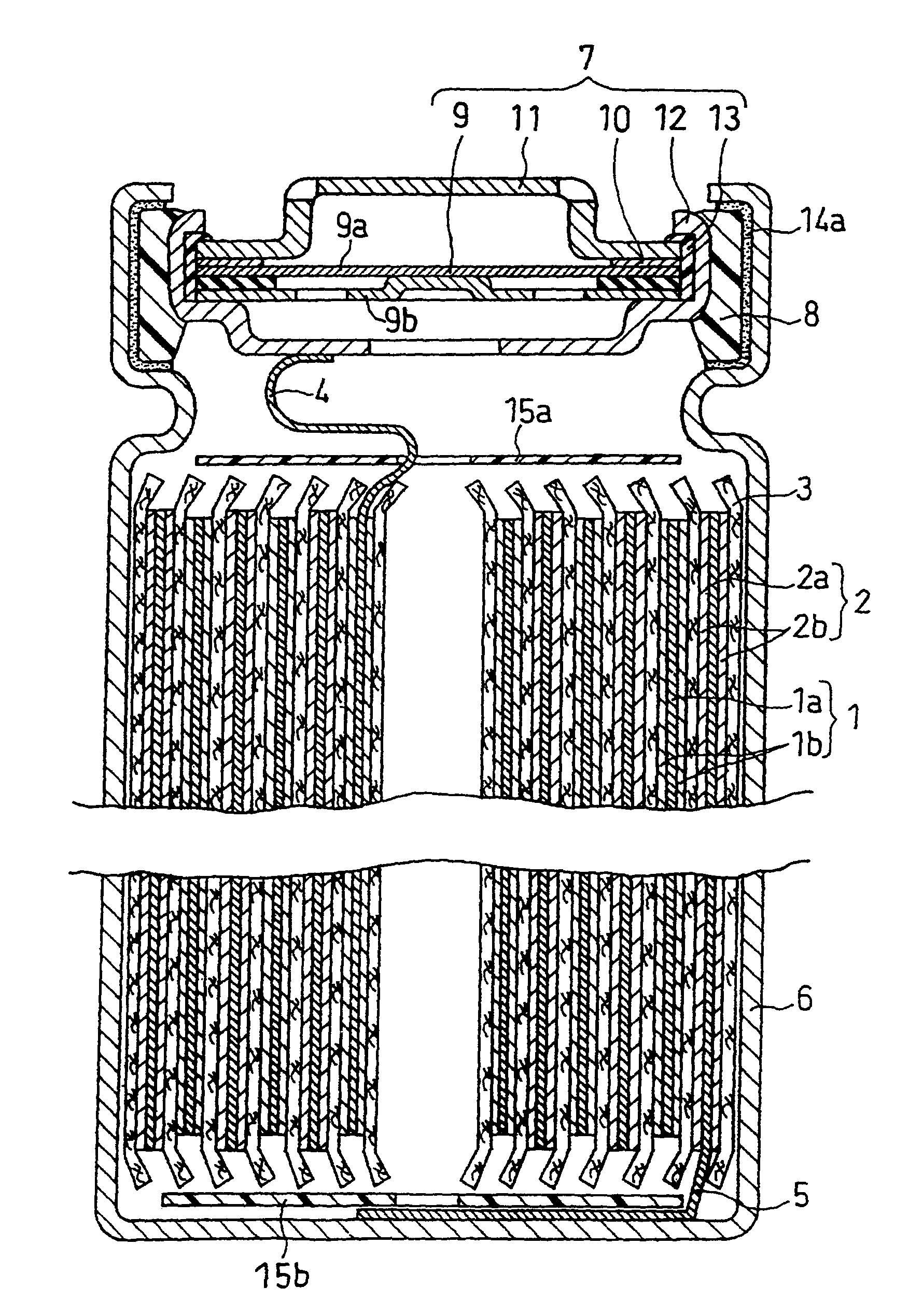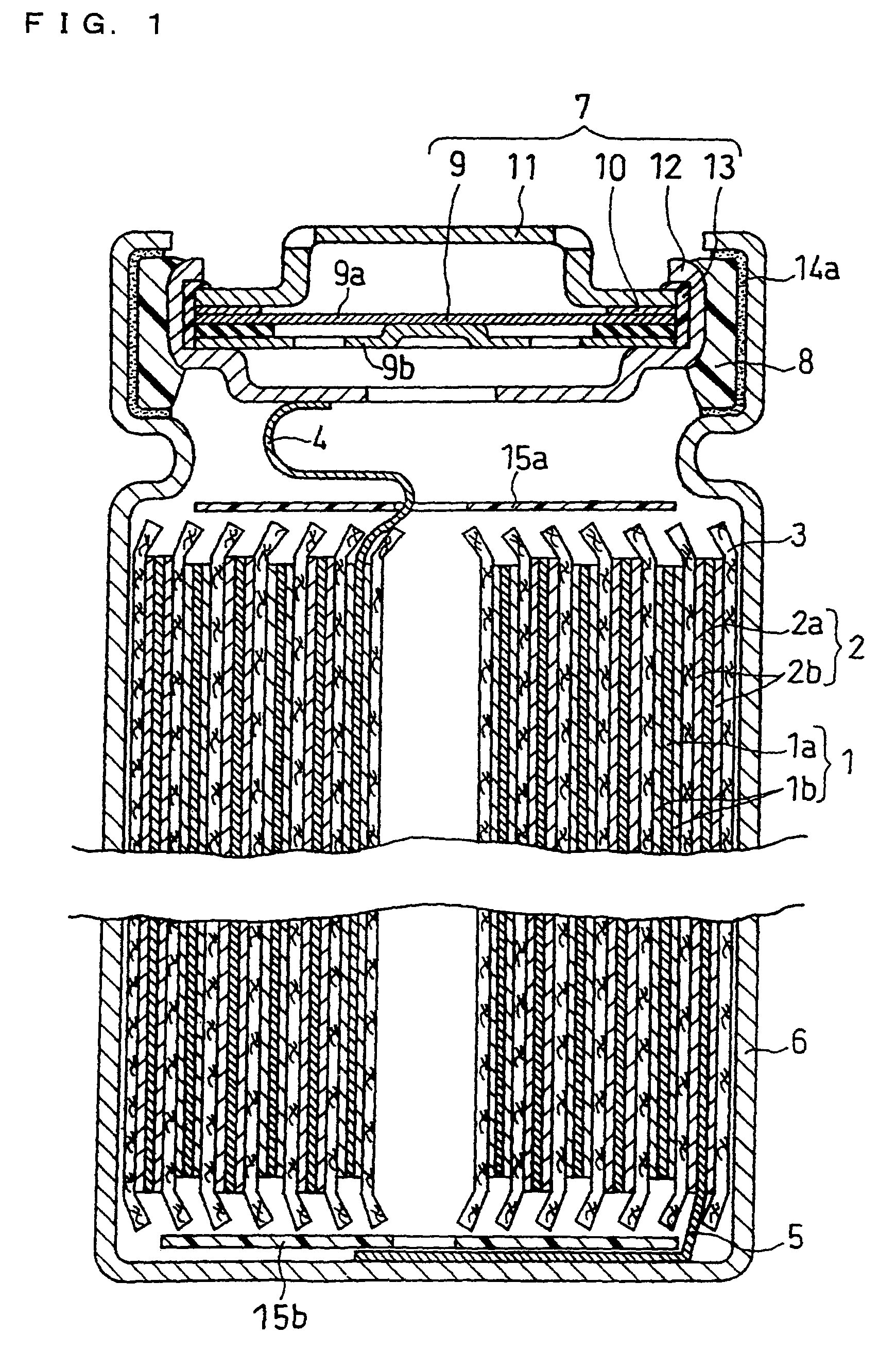Battery
a battery and structure technology, applied in the field of batteries, can solve the problems of overheating and heat generation of batteries, and achieve the effects of preventing short circuits, high capacity, and excellent safety
- Summary
- Abstract
- Description
- Claims
- Application Information
AI Technical Summary
Benefits of technology
Problems solved by technology
Method used
Image
Examples
first embodiment
(i) First Embodiment
[0042]A battery according to this embodiment includes: a battery case having a bottom, a side wall, and an upper opening; an electrode assembly; an electrolyte; a sealing plate covering the upper opening of the battery case accommodating the electrode assembly and the electrolyte. The electrode assembly includes a positive electrode, a negative electrode, and a separator interposed between the positive electrode and the negative electrode. A gasket is interposed between the opening-edge portion of the battery case and the sealing plate. The battery of this embodiment has a first highly-resistive layer disposed between the opening-edge portion of the battery case and the gasket. By configuring as described above, it is possible to prevent a short circuit between the battery case and the sealing plate by virtue of the first highly-resistive layer when the gasket becomes thinner due to the inclusion of foreign matters and the like or even when the gasket is broken, ...
second embodiment
(ii) Second Embodiment
[0053]A battery according to this embodiment does not have the first highly-resistive layer disposed between the opening-edge portion of the battery case and the gasket and has a second highly-resistive layer disposed between the sealing plate and the gasket. By configuring as described above, it is possible to prevent a short circuit between the sealing plate and the battery case by virtue of the second highly-resistive layer even when the gasket is broken, and therefore to provide a battery having an excellent safety. The battery according to this embodiment basically has the same configuration as the battery according to the above-described first embodiment except the above, and the detailed description thereof is omitted. This embodiment is particularly suitable for cylindrical or coin batteries, but also applicable to prismatic batteries.
[0054]FIG. 3 is a longitudinal cross-sectional view schematically showing a cylindrical lithium ion secondary battery ac...
third embodiment
(iii) Third Embodiment
[0059]A battery according to this embodiment has both the first highly-resistive layer and the second highly-resistive layer. FIG. 5 is an enlarged view of a main part of a cylindrical lithium ion secondary battery according to this embodiment. The battery shown in FIG. 5 has the first highly-resistive layer 14a between the opening-edge portion of the battery case 6 and the gasket 8 and the second highly-resistive layer 14b between the sealing plate 7 and the gasket 8.
[0060]By providing both the first highly-resistive layer and the second highly-resistive layer, short circuit can be more reliably prevented, and a battery having a more excellent safety can be provided. Here, it is preferable that the first highly-resistive layer is disposed on an entire area where the battery case and the gasket face to each other, and the second highly-resistive layer is disposed on an entire area where the sealing plate and the gasket face to each other. This improves the effe...
PUM
| Property | Measurement | Unit |
|---|---|---|
| thickness | aaaaa | aaaaa |
| thickness | aaaaa | aaaaa |
| resistivity | aaaaa | aaaaa |
Abstract
Description
Claims
Application Information
 Login to View More
Login to View More - R&D
- Intellectual Property
- Life Sciences
- Materials
- Tech Scout
- Unparalleled Data Quality
- Higher Quality Content
- 60% Fewer Hallucinations
Browse by: Latest US Patents, China's latest patents, Technical Efficacy Thesaurus, Application Domain, Technology Topic, Popular Technical Reports.
© 2025 PatSnap. All rights reserved.Legal|Privacy policy|Modern Slavery Act Transparency Statement|Sitemap|About US| Contact US: help@patsnap.com



